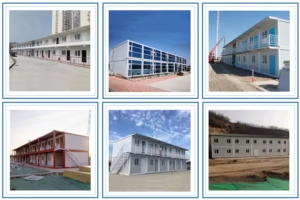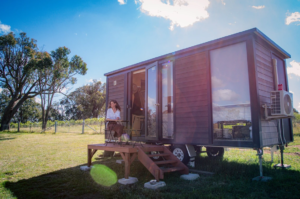In recent years, the housing industry has witnessed a surge in interest toward alternative construction methods, and one of the most innovative trends to emerge is the use of shipping containers to create homes. When stacked strategically, these containers can form multi-level structures, creating unique, sustainable, and cost-effective living spaces. The concept of “shipping container homes stacked” offers a modern twist to traditional housing solutions and presents several advantages, from environmental benefits to affordability and architectural versatility.
What Are Stacked Shipping Container Homes?
Stacked shipping container homes refer to residential buildings constructed by stacking multiple shipping containers on top of one another, often forming multi-story buildings. These homes use standard intermodal containers—used for transporting goods across the globe—as the primary structural units. By modifying and repurposing these containers, architects and builders can create homes that are functional, stylish, and eco-friendly.
The Appeal of Stacked Shipping Container Homes
Affordability
One of the main attractions of shipping container homes is their low cost. Purchasing used shipping containers is often much cheaper than building traditional homes from scratch. The cost-effective nature of these containers, coupled with the relatively low price of materials needed for insulation, finishes, and utilities, makes stacked shipping container homes an attractive option for budget-conscious homeowners and developers.
Environmental Sustainability
Repurposing shipping containers for residential use is an environmentally friendly option. By recycling these steel containers, we are preventing them from ending up in landfills, where they would take years to decompose. Moreover, these homes can be designed with energy-efficient systems such as solar panels, rainwater harvesting, and high-quality insulation to minimize their carbon footprint.
Durability and Strength
Shipping containers are made of high-quality steel, which means they are incredibly strong and durable. This makes them a perfect building block for stacked homes, as they can support each other and withstand harsh weather conditions. Whether in hurricane-prone areas or locations with heavy snowfall, shipping containers provide a robust structure that is resistant to rust, termites, and other typical housing challenges.
Modular and Flexible Design
Shipping containers’ modular nature enables a high degree of customization. Builders can stack multiple containers to design multi-level homes with various layouts and configurations. Architects can align the containers horizontally or vertically, connect them with passageways, or even separate them to create private units. This adaptable and scalable design approach offers a versatile option for both single-family homes and multi-family complexes.
Speed of Construction
Traditional home construction can take months or even years, but stacking shipping containers reduces build time significantly. Since the containers are already pre-made and only require modifications, the construction process is much faster. This makes it ideal for individuals looking to move into a new home quickly or developers who need to complete projects within a short timeframe.
Design Possibilities for Stacked Shipping Container Homes
The design potential for stacked shipping container homes is vast, with opportunities for both creativity and practicality. Here are a few examples of how these homes can be designed:
-
Vertical Urban Housing
In densely populated cities where space is limited, architects and urban planners use stacked shipping containers as a smart solution for vertical housing. Builders can stack these multi-story homes to maximize floor space, making them ideal for urban environments with scarce and expensive land. The modular nature of container homes also enables homeowners to expand their living space easily in the future. -
Eco-Friendly Communities
Several eco-conscious communities are emerging that focus on sustainable living. By using shipping containers, these communities can create affordable, eco-friendly homes with minimal environmental impact. Incorporating green technologies such as solar panels, energy-efficient lighting, and green roofs can further enhance the sustainability of these homes. -
Tiny Home Communities
The tiny home movement has grown in popularity, with many people seeking smaller, more affordable living spaces. Stacked shipping container homes are perfect for tiny home communities, offering a low-cost way to create compact and functional homes. The modular design of containers allows residents to add or remove units as needed, creating a flexible community layout. -
Luxury Container Homes
Stacked shipping container homes don’t have to be simple or utilitarian. Some architects have turned these containers into luxurious, modern homes with sleek finishes, open floor plans, and spacious interiors. With the right design, stacked containers can become high-end residences with features like rooftop gardens, glass walls, and state-of-the-art appliances.
Challenges and Considerations
While stacked shipping container homes offer many benefits, there are some challenges to consider:
-
Zoning and Building Codes
One of the most significant challenges is navigating local zoning laws and building codes. In many areas, shipping container homes are still considered unconventional and may face regulatory hurdles. Before embarking on a project, it is crucial to work with local authorities to ensure compliance with codes and obtain the necessary permits. -
Insulation and Temperature Control
Steel makes up shipping containers, and it conducts heat and cold, so builders must prioritize insulation. Without proper insulation, extreme temperatures can make container homes unbearably hot in summer or freezing in winter. Properly insulating the containers ensures a comfortable living space. -
Transportation and Site Preparation
While shipping containers are easy to transport, getting them to the construction site and placing them in the right location can be challenging. Depending on the site’s location and accessibility, transportation costs may add to the overall project cost. Additionally, preparing the foundation for stacked containers requires careful planning to ensure structural stability.
Conclusion
Stacked shipping container homes offer a creative and sustainable housing solution, blending modern architecture with environmental consciousness. Whether you’re looking to build an affordable home, create a unique community, or design a luxury residence, the possibilities are endless when using shipping containers. With the right planning, design, and modifications, these homes can serve as a durable, eco-friendly alternative to traditional housing, all while offering a quick and cost-effective construction process.
As the popularity of shipping container homes continues to grow, it’s likely that we’ll see more innovative designs and solutions that help address housing shortages, environmental concerns, and urbanization challenges.
✨ Explore our high-quality products – Get a free quote instantly or a personalized custom solution tailored to your needs!
📱 Chat on WhatsApp:+86-13081655379
▶️ Watch product videos on YouTube: WeiFang Carterhouse



